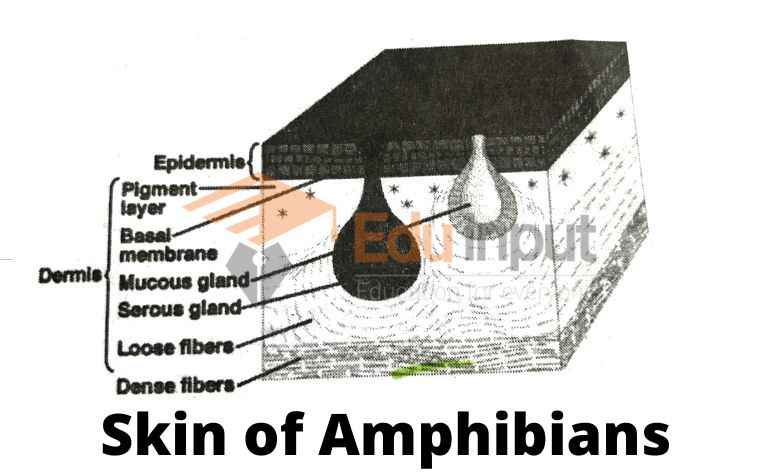The skin of Amphibian-Composition and Adaptations
Amphibians are animals that live both on land and in water. They breathe through their skin and they don’t have lungs. The skin of amphibians has pores called spiracles. These pores allow them to absorb oxygen from the air and release carbon dioxide into the environment.
Amphibian skin looks very similar to human skin. Some scientists believe that humans evolved from amphibians.
Also Read About Ear Of Amphibians
Composition Of Amphibian Skin
Amphibian skin consists of a stratified (composed of many layers) epidermis. Its dermis contains mucous and serous glands. It also contains pigmentation cells. Amphibians are transitional and give colors state between aquatic and terrestrial vertebrates.

The earliest amphibians were covered by dermal bone scales. These dermal bones were present in their fish ancestors. Terrestrial animals face three problems:
Desiccation
Desiccation can be defined as the state of extreme dryness or the process of extreme drying.
The effect of desiccation is different on different organisms; it causes damage to some and death to others. In humans, it can lead to skin irritation, eye irritation, diarrhea, nausea, headache, abdominal cramps, fatigue, and muscle weakness.
Dehydration
Dehydration can be caused by the loss of too much fluid. it happens When usage of fluids is more than the intake of water.
What Causes Dehydration?
When the level of water in our body gets low, our body starts to lose its electrolytes and minerals. It causes the cells to get damaged and also the body’s functions become slow. Causes of dehydration:
Physical Abrasion
Abrasions are caused by skin rubbing against a rough surface. In some cases, the abrasive is inorganic. For example, abrasives may include sand, gravel, and other particulate matter. The abrasive is usually in contact with the skin for a period of time to cause damage to the skin.
The extent of injury to the skin depends upon the type of abrasive and the duration of contact between the abrasive and the skin. In addition, abrasives may also be organic. For example, abrasives may include a chemical irritant.
Adaptations In Amphibians
There are the following adaptations in amphibians to solve these problems:
Keratinization
Keratin is a tough, impermeable protein that protects the skin in the physically abrasive, rigorous terrestrial environment. Keratin production increases during amphibian evolution. Keratin is present in the outer layer of skin cells. The increased keratin in the skin also protects the cells. It protects the nuclear material from ultraviolet light.
Mucous Gland
Mucous glands produce mucus.
Functions Of Mucous
Mucous performs the following function:
- It prevents them from desiccation (dehydration).
- Mucous keep the skin moist. Thus it helps in gas exchange.
- It makes the body slimy. Thus these animals are escaped from predators.
Poisonous Glands
Poison glands are present within the dermis of some amphibians. It produces an unpleasant taste or toxic fluid. This fluid acts as a predator deterrent (discourage predator).
Sensory Nerves
Sensory nerves penetrate the epidermis. It has free nerve endings. Warts (rough) of toads are specialized sensory structures. These parts contain many sensory cells.



Leave a Reply